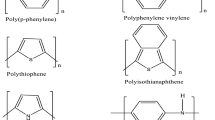Abstract
A series of 2,3-difunctionalized 5,7-bis(2-thienyl)thieno[3,4-b]pyrazines containing electron-donating and electron-withdrawing side chains are reported to evaluate the potential tuning effect of the side chains on the electronic properties of these common terthienyl building blocks. In order to further study the resulting effects of such side chains in polymeric materials, the dihexyloxy-functionalized terthienyl was copolymerized with fluorene and its electronic properties compared with a number of analogous materials.






Similar content being viewed by others
References
Roncali J (1997) Synthetic principles for bandgap control in linear π-conjugated systems. Chem Rev 97:173–205
Rasmussen SC, Pomerantz M (2007) Low band gap conducting polymers, chapter 12. In: Skotheim TA, Reynolds JR (eds) Handbook of conducting polymers, vol 1, 3rd edn. CRC Press, Boca Raton
Rasmussen SC, Ogawa K, Rothstein SD (2008) Synthetic approaches to band gap control in conjugated polymeric materials, chapter 1. In: Nalwa HS (ed) Handbook of organic electronics and photonics, vol 1. American Scientific Publishers, Stevenson Ranch
Rasmussen SC, Schwiderski RL, Mulholland ME (2011) Thieno[3,4-b]pyrazines and their applications to low band gap organic materials. Chem Commun 47:11394–11410
Wudl F, Kobayashi M, Heeger AJ (1984) Poly(isothianaphthene). J Org Chem 49:3382–3384
Kobayashi M, Colaneri N, Boysel M, Wudl F, Heeger AJ (1985) The electronic and electrochemical properties of poly(isothianaphthene). J Chem Phys 82:5717–5723
Kenning DD, Mitchell KA, Calhoun TR, Funfar MR, Sattler DJ, Rasmussen SC (2002) Thieno[3,4-b]pyrazines: synthesis, structure, and reactivity. J Org Chem 67:9073–9076
Rasmussen SC, Sattler DJ, Mitchell KA, Maxwell J (2004) Photophysical characterization of 2,3-difunctionalized thieno[3,4-b]pyrazines. J Lumin 190:111–119
Wen L, Nietfeld JP, Amb CM, Rasmussen SC (2008) Synthesis and characterization of new 2,3-disubstituted thieno[3,4-b]pyrazines: tunable building blocks for low band gap conjugated materials. J Org Chem 73:8529–8536
Rasmussen SC, Mulholland ME, Schwiderski RL, Larsen CA (2011) Thieno[3,4-b]pyrazines and its extended analogues: important buildings blocks for conjugated materials. J Heterocycl Chem 48. doi:10.1002/jhet.1051
Wen L, Nietfeld JP, Amb CM, Rasmussen SC (2009) New tunable thieno[3,4-b]pyrazine-based materials. Synth Met 159:2299–2301
Perzon E, Wang X, Zhang F, Mammo W, Delgado JL, de la Cruz P, Inganas O, Langa F, Andersson MR (2005) Design, synthesis and properties of low band gap polyfluorenes for photovoltaic devices. Synth Met 154:53–56
Zhang F, Perzon E, Wang X, Mammo W, Andersson MR, Inganas O (2005) Polymer solar cells based on a low-bandgap fluorene copolymer and a fullerene derivative with photocurrent extended to 850 nm. Adv Funct Mater 15:745–750
Admassie S, Inganas O, Mammo W, Perzon E, Andersson MR (2006) Electrochemical and optical studies of the band gaps of alternating polyfluorene copolymers. Synth Met 156:614–623
Zhu Y, Champion RD, Jenekhe SA (2006) Conjugated donor-acceptor copolymer semiconductors with large intramolecular charge transfer: synthesis, optical properties, electrochemistry, and field effect carrier mobility of thienopyrazine-based copolymers. Macromolecules 39:8712–8719
Lee W, Cheng K, Wang T, Chueh C, Chen W, Tuan C, Lin J (2007) Effects of acceptors on the electronic and optoelectronic properties of fluorene-based donor–acceptor–donor copolymers. Macromol Chem Phys 208:1919–1927
Helgesen M, Krebs FC (2010) Photovoltaic performance of polymers based on dithienylthienopyrazines bearing thermocleavable benzoate esters. Macromolecules 43:1253–1260
Zhou E, Cong J, Yamakawa S, Wei Q, Nakamura M, Tajima K, Yang C, Hashimoto K (2010) Synthesis of thieno[3,4-b]pyrazine-based and 2,1,3-benzothiadiazole-based donor-acceptor copolymers and their application in photovoltaic devices. Macromolecules 43:2873–2879
Chao C-Y, Lim H, Chao C-H (2010) Molecular engineering of conjugated copolymers for photoactive layer in polymer solar cells. Polym Prepr 51(1):715–716
Kitamura C, Tanaka S, Yamashita Y (1994) Synthesis of new narrow bandgap polymers based on 5,7-di(2-thienyl)thieno[3,4-b]pyrazine and its derivatives. J Chem Soc Chem Commun 1585–1586
Kitamura C, Tanaka S, Yamashita Y (1996) Design of narrow-bandgap polymers. Syntheses and properties of monomers and polymers containing aromatic-donor and o-quinoid-acceptor units. Chem Mater 8:570–578
Cho SY, Grimsdale AC, Jones DJ, Watkins SE, Holmes AB (2007) Polyfluorenes without monoalkylfluorene defects. J Am Chem Soc 129:11910–11911
Larson RC, Iwamoto RT, Adams RN (1961) Reference electrodes for voltammetry in acetonitrile. Anal Chim Acta 25:371–374
Cardona CM, Li W, Kaifer AE, Stockdale D, Bazan GC (2011) Electrochemical considerations for determining absolute frontier orbital energy levels of conjugated polymers for solar cell applications. Adv Mater 23:2367–2371
Acknowledgments
The authors wish to thank the National Science Foundation (DMR-0907043) and North Dakota State University for support of this research.
Author information
Authors and Affiliations
Corresponding author
Rights and permissions
About this article
Cite this article
Mulholland, M.E., Schwiderski, R.L. & Rasmussen, S.C. Structure–function relationships in conjugated materials containing tunable thieno[3,4-b]pyrazine units. Polym. Bull. 69, 291–301 (2012). https://doi.org/10.1007/s00289-012-0718-x
Received:
Revised:
Accepted:
Published:
Issue Date:
DOI: https://doi.org/10.1007/s00289-012-0718-x




